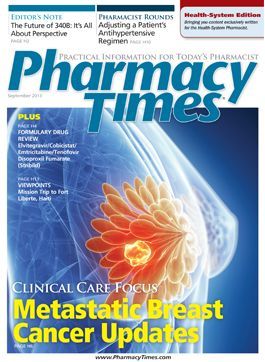Mission Trip to Fort Liberte, Haiti
A pharmacist's services prove to be invaluable on a medical mission trip to Fort Liberte, Haiti.
Opportunity is defined as the chance for advancement or progress. Pursuing a postgraduate year 2 (PGY2) specialized in emergency medicine has led to many opportunities. No opportunity has been more gratifying than having the privilege of traveling to Fort Liberte, Haiti, for a medical mission trip with the emergency department team from The Ohio State University Wexner Medical Center (OSUWMC).
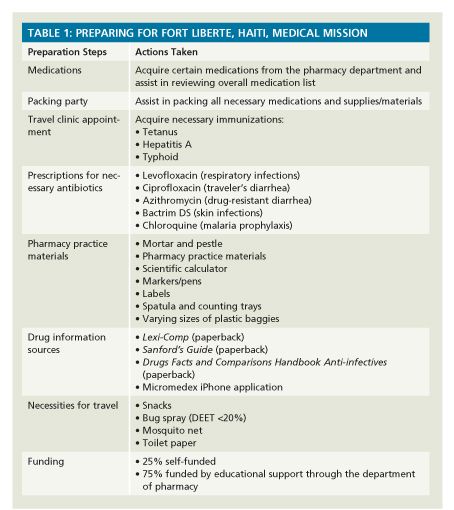
As a PGY2 emergency medicine pharmacy resident at OSUWMC, an opportunity arose to serve as the pharmacist on a 9-day medical mission trip to Fort Liberte, Haiti. Nineteen members comprised the team: emergency medicine physicians (6), cardiologist (1), pediatric nurse practitioners (4), social worker (1), nonmedical personnel (3), nurses (3), and myself as the pharmacist.
Preparation for the trip included several steps, such as obtaining vaccinations recommended for travelers to this region (Table 1). A prerequisite to traveling to Fort Liberte included attending the “packing party.” During this meeting, everyone brought 1 piece of luggage and ensured that all medications and supplies were properly packed. Drug information resources were also needed for the mission trip. Paperback resources were recommended, as Internet service was not provided in the clinic and access to phone applications could be unreliable. In addition to drug information resources, items necessary for pharmacy practice were also packed for the mission trip (eg, mortar and pestle). Educational support through the residency program assisted with the financial burden associated with travel.
A “Haiti Medications Cheat Sheet” proved invaluable, as it highlighted anticipated disease states and first-line treatments that would be encountered in Fort Liberte. The role of the pharmacist on this mission was simple, yet daunting: handle anything and everything dealing with medication. Handling it all meant understanding appropriate substitutions, dose adjustments, reconstituting medications, and updating the mission team daily on medication inventory, in addition to organizing, stocking, and developing a flow within the pharmacy in regard to receiving and dispensing medication orders.
With flights arranged, passports ready, and bags packed, the mission trip was ready to be taken. As a result of the “packing party,” everyone in the group had at least 1 piece of checked luggage. From Columbus, Ohio, to Miami, Florida, and onward to Santiago, Dominican Republic, everyone arrived safely and was ready for travel into Fort Liberte, Haiti. A letter was provided to customs officials in the Dominican Republic stating the purpose of travel and the reason behind the multiple suitcases filled with medications.
After a 6-hour bus ride from Santiago, the group arrived in Fort Liberte, Haiti. Unpaved dusty roads and hot air greeted the group. The first 2 days consisted of unpacking medications and supplies, stocking the clinic, and organizing the hot, dirty, and disorganized pharmacy (online Figure 1).
Figure 1: First Impression, Pharmacy

After an initial moment of panic and a couple of deep breaths, a plan was established to set up the pharmacy (online Figure 2).
Figure 2: Initial Plan for Pharmacy Operations

Prescription labels were adapted from labels previously used on another mission trip to Central America by one of the emergency department physicians. These labels had an ingenious design, conveying the message of how to take medications to the Haitian patients by using mostly pictures (online Figure 3).
Figure 3: Prescription Labels
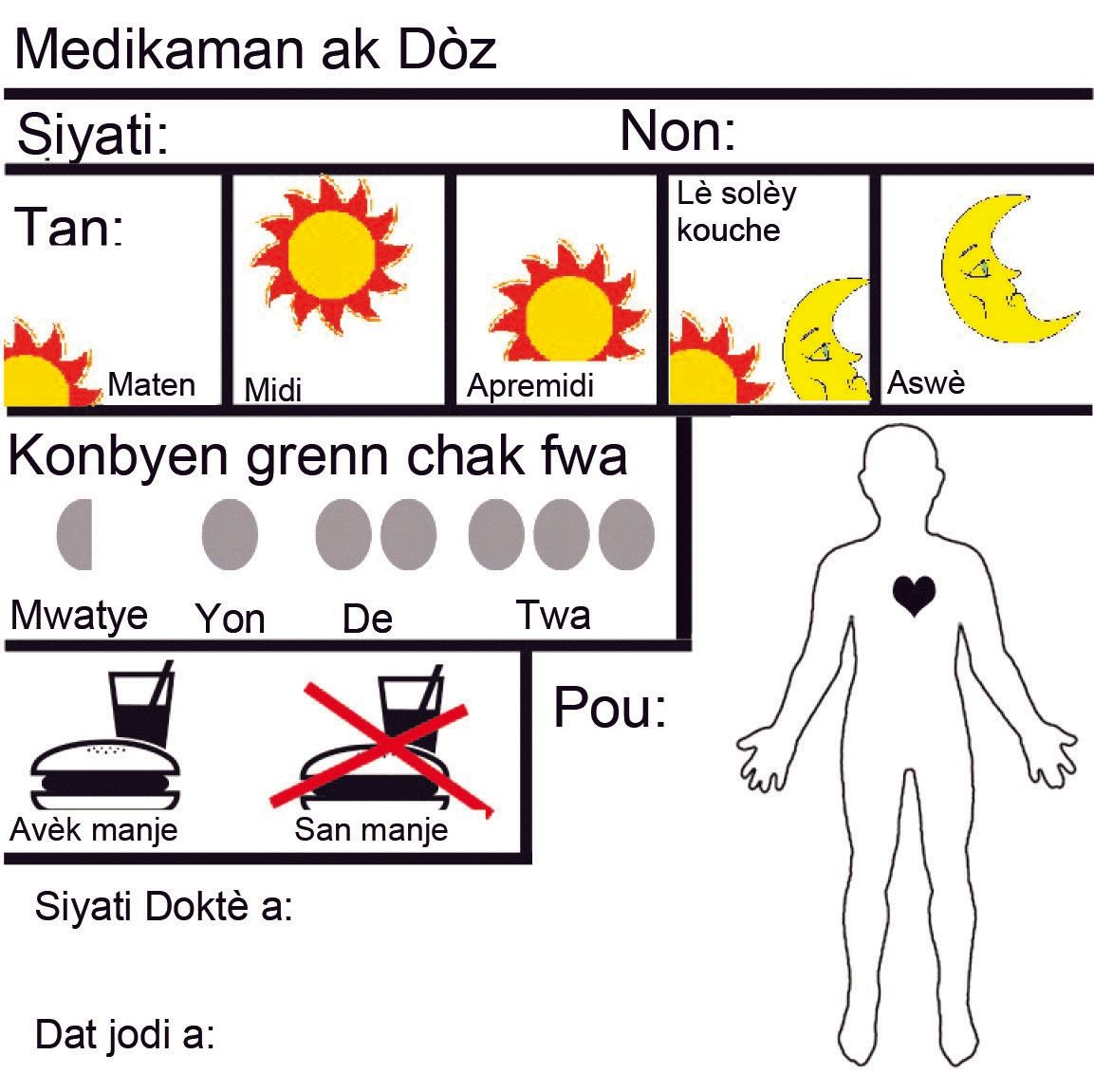
Stocked with medications, drug information materials, labels, markers, pens, and a calculator, the pharmacy was prepared for the clinic days ahead. The clinic was open to the residents of Fort Liberte, Haiti, for 5 days, with the fifth being a callback day. In addition, there were outreach posts in which some physicians, nurse practitioners, and nurses traveled to provide care for patients who did not have the opportunity to reach the clinic.
Crowds of people surrounded the clinic doors each day, asking questions about their health of every person who walked in the clinic. Days were long, hot, and exhausting. In the pharmacy, staff began with prepacking medications that went quickly (eg, vitamins, analgesics, antibiotics). At least 1 other health care provider was in the pharmacy at all times in addition to the pharmacist. The patient charts comprised the patient’s demographic information, past medical history, diagnoses for their visit, and medications to be dispensed. Once orders began to appear, they were filled in a systematic way (online Figure 4).
Figure 4: Medication Filling Operations
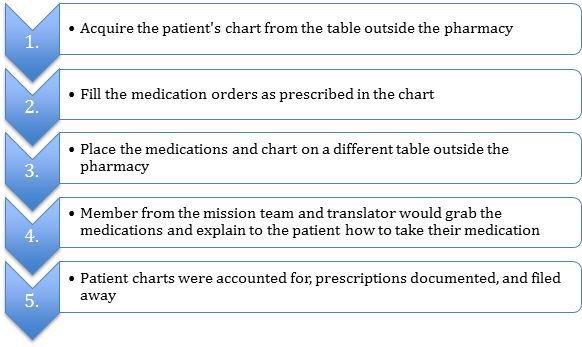
Drug information questions from health care personnel were addressed using paperback resources, medication package inserts, and thankfully, the Micromedex iPhone application. Clinic hours were 9 am to 7 pm.
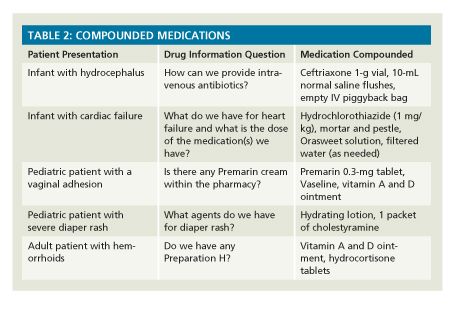
While all days were busy, no day was like the other. Medications were compounded with few resources. A ceftriaxone intravenous piggyback was compounded for an infant with hydrocephalus who had a central nervous system infection. This was accomplished using the ceftriaxone package insert, ceftriaxone 1-g vial, 10-mL normal saline flushes, and a 50-mL empty intravenous piggyback bag. Each day presented interesting challenges (Table 2).
A mortar and pestle was used to compound suspensions and triturate medications to be incorporated into topical ointments. An area for compounding was created by using a flat cardboard surface, paper towels, and plastic bags to incorporate medications into ointments or lotions.
Approximately 1250 patients were seen during this mission trip. Each patient received an average of 3 to 4 prescriptions. More common disease states encountered included infectious diseases, hypertension, and malnutrition.
Due to the limited inventory of medications available, an understanding was developed among the pharmacist, physicians, and nurse practitioners to provide suitable alternatives to optimize patient care. As stated by the International Pharmaceutical Federation:
“Pharmacists and Pharmaceutical scientists accept responsibility and accountability for improving global health and patient health outcomes by closing gaps in the development, distribution, and responsible use of medicines.”
Being able to work not only with the OSUWMC health care professional group but also with the Haitian physicians was a gratifying experience. Haitian physicians learn medicine in Spanish. Having the ability to translate between the Haitian physicians and the mission team proved invaluable. Also, understanding exactly what they needed in order to treat a specific disease state for their patient with the medications on hand was vital.
“Phenomenal” is the only word suitable when describing this experience. From developing an operational process in the pharmacy to answering drug information questions to compounding medications, being the pharmacist on the mission team was a great task to undertake. It allowed further development of relationships between emergency medicine residents, physicians, and nurses, as well as the opportunity to build new relationships with the physicians from Haiti, and hopefully, establish a lifelong relationship with the residents and patients of Fort Liberte.
Ruben Santiago, BS, PharmD, is a clinical pharmacist in emergency medicine at the Boston Medical Center.
